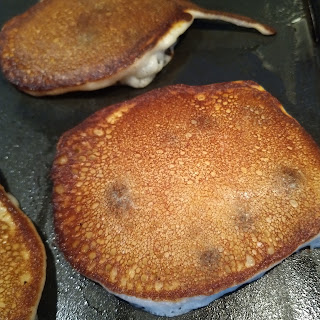Grandma's Secret Recipe: Sourdough
For years my grandmother Monica would make sourdough pancakes with blueberries or, more often, with wild Oregon huckleberries. She had a berry bush in the yard in Coos Bay and we grandkids would get up early and pick (and eat) some berries for the pancakes. What I didn’t realize until I was an adult was that she had prepared for the pancakes the night ahead.A couple years after college I was visiting my grandmother when
she gave me some of her sourdough starter and the recipe for her pancakes. The night before she removed a jar of started
from the refrigerator and added that to a bowl with 1 cup of milk and 1 cup of
flour. In the morning she saved 1 cup of
starter in her jar and then used the rest to make the pancakes.
She had received her sourdough starter from a family friend
who had had it going since the early 1960s.
I had just bought a house and the starter went into the refrigerator in
the new place as a housewarming gift. I kept the starter going for years after
that and was even able to return some of it her on the occasion when she forgot
to save out a cup after making pancakes. Unfortunately, in the 2000s our
refrigerator died one hot summer and the starter turned blackish gray. I should
have fed it but instead ended up tossing it (along with most of the contents of
the fridge).
Restarting the Starter
A couple weeks ago my friend Molly gave me some of her sourdough
starter. She’s a big fan of the King Arthur’s Flour website for sourdoughbaking tips and had been posting her recent baking adventures. I figured it was time to get back into baking
with sourdough. Also I had a secret goal: I had recently picked a lot of fresh
blueberries and wanted to make my grandmother’s sourdough pancakes.
When I got the starter from Molly, however, I had a slightly
embarrassing question. I had read an article in the Oregonian about what to do
with your sourdough discard. All of my
recipes came from my grandmother and she never mentioned anything about a
discard. So I had to admit, aside from the
alcohol that forms on the top of the starter, I had never discarded anything.
What is the discard?
Molly was nice enough to explain that most recipes called
for creating large amount of starter, and then to use only a portion of that in
the baking and to discard the rest. It
suddenly clicked for me: My grandmother’s sourdough pancake recipe was
the discard recipe. She used the
sourdough for flavoring and not so much for a rise.
Handling Sourdough
My grandmother had some special rules for sourdough that I’m
not sure about:
1)
Use milk for the starter. I’ve done it both
ways, with milk and with water. Both ways work.
2)
Don’t let the starter touch metal. Use porcelain
or glass bowls, use a wooden spoon for mixing and put a piece of Saran Wrap
under between the metal lid and the glass jar for storing the starter.
Thanks to Molly for the insight and to my grandmother Monica
for all the times she served up pancakes. Here’s my grandmother’s recipe for
sourdough pancakes based on the discard.
Make sure you add lots of fresh blueberries or, if you’re lucky enough,
Oregon wild huckleberries.
Recipe for Sourdough Pancakes (with berries)
The night before, put the starter into a porcelain bowl with
1 cup of flour and 1 cup of milk. Stir to mix.
In the morning be sure to remove save 1 cup of starter back
into the refrigerator.
To the rest add:
- 1 egg
- 2 tablespoons of neutral oil like canola
- 2 tablespoons of sugar
- 1 teaspoon of baking soda
- 1 teaspoon of salt (can be less)
This recipe makes about 8 pancakes. If you want to make
more, just double everything in the recipe, including the flour and milk in the
overnight bowl. Just remember to always
save 1 cup of starter before adding eggs, etc.



